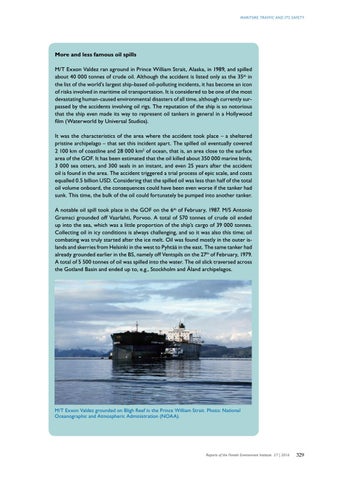Maritime tr affic and its safety
More and less famous oil spills M/T Exxon Valdez ran aground in Prince William Strait, Alaska, in 1989, and spilled about 40 000 tonnes of crude oil. Although the accident is listed only as the 35th in the list of the world’s largest ship-based oil-polluting incidents, it has become an icon of risks involved in maritime oil transportation. It is considered to be one of the most devastating human-caused environmental disasters of all time, although currently surpassed by the accidents involving oil rigs. The reputation of the ship is so notorious that the ship even made its way to represent oil tankers in general in a Hollywood film (Waterworld by Universal Studios). It was the characteristics of the area where the accident took place – a sheltered pristine archipelago – that set this incident apart. The spilled oil eventually covered 2 100 km of coastline and 28 000 km2 of ocean, that is, an area close to the surface area of the GOF. It has been estimated that the oil killed about 350 000 marine birds, 3 000 sea otters, and 300 seals in an instant, and even 25 years after the accident oil is found in the area. The accident triggered a trial process of epic scale, and costs equalled 0.5 billion USD. Considering that the spilled oil was less than half of the total oil volume onboard, the consequences could have been even worse if the tanker had sunk. This time, the bulk of the oil could fortunately be pumped into another tanker. A notable oil spill took place in the GOF on the 6th of February, 1987. M/S Antonio Gramsci grounded off Vaarlahti, Porvoo. A total of 570 tonnes of crude oil ended up into the sea, which was a little proportion of the ship’s cargo of 39 000 tonnes. Collecting oil in icy conditions is always challenging, and so it was also this time; oil combating was truly started after the ice melt. Oil was found mostly in the outer islands and skerries from Helsinki in the west to Pyhtää in the east. The same tanker had already grounded earlier in the BS, namely off Ventspils on the 27th of February, 1979. A total of 5 500 tonnes of oil was spilled into the water. The oil slick traversed across the Gotland Basin and ended up to, e.g., Stockholm and Åland archipelagos.
M/T Exxon Valdez grounded on Bligh Reef in the Prince William Strait. Photo: National Oceanographic and Atmospheric Administration (NOAA).
Reports of the Finnish Environment Institute 27 | 2016
329
